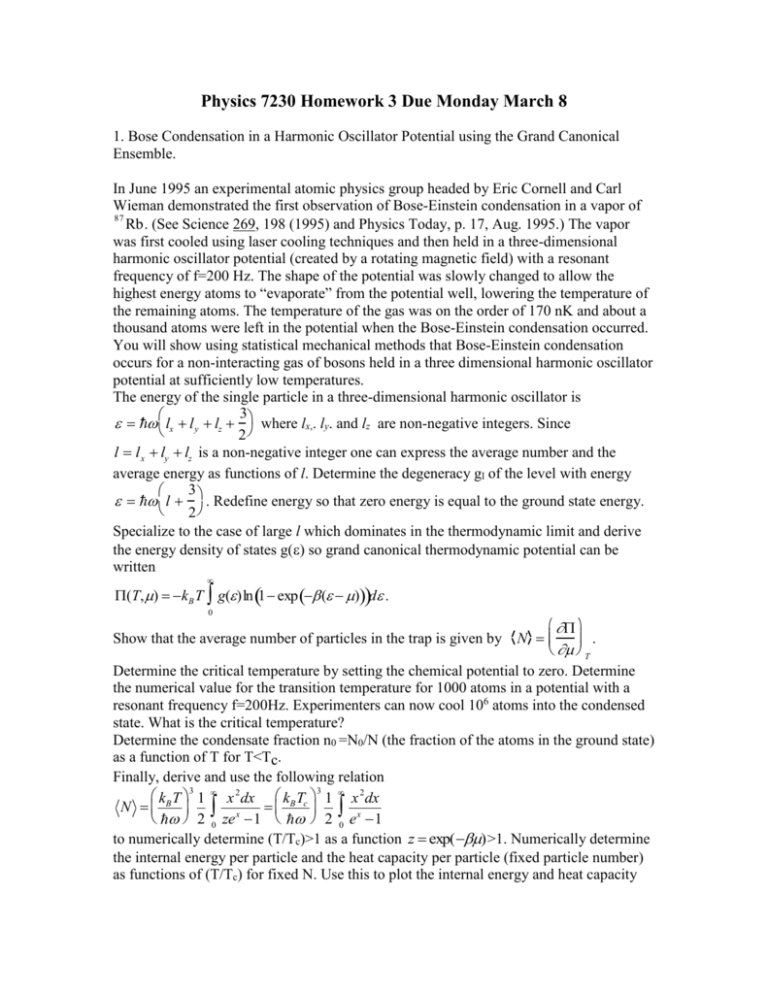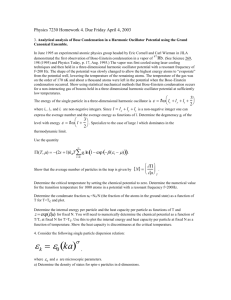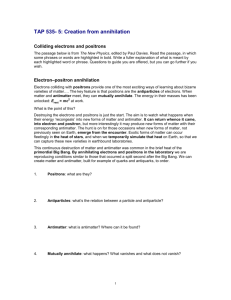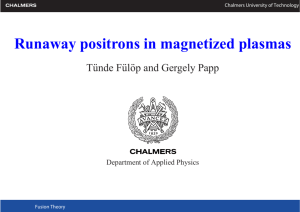1 - University of Colorado Boulder
advertisement

Physics 7230 Homework 3 Due Monday March 8 1. Bose Condensation in a Harmonic Oscillator Potential using the Grand Canonical Ensemble. In June 1995 an experimental atomic physics group headed by Eric Cornell and Carl Wieman demonstrated the first observation of Bose-Einstein condensation in a vapor of 87 Rb . (See Science 269, 198 (1995) and Physics Today, p. 17, Aug. 1995.) The vapor was first cooled using laser cooling techniques and then held in a three-dimensional harmonic oscillator potential (created by a rotating magnetic field) with a resonant frequency of f=200 Hz. The shape of the potential was slowly changed to allow the highest energy atoms to “evaporate” from the potential well, lowering the temperature of the remaining atoms. The temperature of the gas was on the order of 170 nK and about a thousand atoms were left in the potential when the Bose-Einstein condensation occurred. You will show using statistical mechanical methods that Bose-Einstein condensation occurs for a non-interacting gas of bosons held in a three dimensional harmonic oscillator potential at sufficiently low temperatures. The energy of the single particle in a three-dimensional harmonic oscillator is 3 where lx,. ly. and lz are non-negative integers. Since lx l y lz 2 l l x ly lz is a non-negative integer one can express the average number and the average energy as functions of l. Determine the degeneracy gl of the level with energy 3 l . Redefine energy so that zero energy is equal to the ground state energy. 2 Specialize to the case of large l which dominates in the thermodynamic limit and derive the energy density of states g() so grand canonical thermodynamic potential can be written (T, ) k B T g()ln 1 exp ( )d . 0 Show that the average number of particles in the trap is given by N . T Determine the critical temperature by setting the chemical potential to zero. Determine the numerical value for the transition temperature for 1000 atoms in a potential with a resonant frequency f=200Hz. Experimenters can now cool 106 atoms into the condensed state. What is the critical temperature? Determine the condensate fraction n0 =N0/N (the fraction of the atoms in the ground state) as a function of T for T<Tc. Finally, derive and use the following relation k T 3 1 x 2 dx kB Tc 3 1 x 2 dx N B x 2 0 ze 1 2 0 e x 1 to numerically determine (T/Tc)>1 as a function z exp() >1. Numerically determine the internal energy per particle and the heat capacity per particle (fixed particle number) as functions of (T/Tc) for fixed N. Use this to plot the internal energy and heat capacity per particle at fixed N as a function of temperature. Show the heat capacity is discontinuous at the critical temperature. Solution: Lets get the exact degeneracy straight first. l ll1 l l l 2 3l gl l,l1 l2 l3 1 (l 1 l1 ) (l 1) 2 (l 1)( ) 1 2 2 2 l1 0 l 2 0 l 3 0 l1 0 l 2 0 l1 0 If the spin is not zero then there is an extra spin degeneracy factor of (2s+1). Now, after redefining the energy so the ground state is E=0 the energy density of states is l2 2 2 2 3 0 Now the grand potential and average number and integral energy are g() dl( l) 2 (T, ) kB T d ln 1 e ( ) 3 2 0 2 1 N(T, ) d , 3 ( ) 1 T 0 2 e U(T, ) d 0 3 1 , 3 ( ) 1 2 e The Bose-Einstein critical temperature occurs when the chemical potential approaches zero so 3 kB Tc 3 2 1 1 k B Tc x2 N d dx x 3 3 e 1 T 0 2 e c 1 2 0 where n 1 is the Riemann zeta function. For n=3 3=1.202. Therefore the critical n j1 j temperature is N 1/ 3 kB Tc which has a value of 90nK for N=1000 and 900nK for N=106. 3 For T<Tc the number in the ground state is the number missing in the above expression for T<Tc so T 3 N 0 (T) 1 N Tc For T > Tc the number in the trap is given by kB T 1 x 2 dx 2 1 N d 3 ( ) 1 2 0 ze x 1 2 e 0 where z exp() >1. Since this is also the number in the trap at T=Tc we get kB T 3 1 x 2 dx kB Tc 3 1 x 2 dx N x 2 0 ze 1 2 0 e x 1 3 Now we can determine the functional relation between T/Tc and z numerically by evaluating the integral for a series of z > 1 to determine a series of T/Tc values. Mathematica can evaluate the integral or you can expand the denominator using the binomial theorem and evaluate term by term to turn the integral into a rapidly converging sum using the variable y=1/z < 1 T 3 1 y j 3 (y) 3 3 Tc 3 j1 j Title: Graphics produced byIDL Creator: IDLVersion 6.0, Mac OSX(darwinppc m32) Preview: This EPS picture was not saved witha preview(TIFF or PICT) included in it Comment: This EPS picture will print to a postscript printer but not to other types of printers Once the numerical relation between z and T/Tc is determined the internal energy is easily evaluated numerically k B T 4 x 3 dx 3 1 U(T, ) d 3 ( ) 1 2 0 ze x 1 2 e 0 which is easily recast into a dimensionless form dxx 3 4 T ze x 1 T 3 4 (y) U 0 3 . NkB Tc Tc 2 3 Tc 3 Title: Graphics produced byIDL Creator: IDLVersion 6.0, Mac OSX(darwinppc m32) Preview: This EPS picture was not saved witha preview(TIFF or PICT) included in it Comment: This EPS picture will print to a postscript printer but not to other types of printers Likewise the heat capacity can also be written in a dimensionless form and evaluated once T/Tc vs. z is determined numerically. U N U U y T T u k B T 3 9 3 2 (y) CN (T) kB 12 (y) N T N T y 4 2 (y) y T 3 CN (T) 1 T 9 3 2 (y) 12 4 (y) NkB 3 Tc 2 (y) Title: Graphics produced byIDL Creator: IDLVersion 6.0, Mac OSX(darwinppc m32) Preview: This EPS picture was not saved witha preview(TIFF or PICT) included in it Comment: This EPS picture will print to a postscript printer but not to other types of printers 2. Consider the single particle dispersion relation k 0 ka , where 0 and a are microscopic parameters, and k is the quantized wavevector for particles in a d-dimensional periodic box. Determine the density of states for spin-s particles in d-dimensions. Show it is of the form g() g0 . Show that can be positive or negative for physically realizable values of and d. The density of points in k-space is Ld/(2)d. Since the energy is a function of the magnitude the wavevector the density of states is d g() d 2 dkk 0 Therefore d 0 ka d 1 d 2 0 a d k d k 1/ a 01/ d 1 d 2 0 a d 0 d 1. For free nonrelativistic particles =2 so =1/2 in three dimensions, =-1/2 in one dimension, and =0 in two dimensions. For relativistic particles =1 so =0 in one dimension but is positive for higher dimensions. 3. For Bose (integer spin) particles with a power law density of states the pressure is given by p(T,) kB T dg()ln 1 e ( ) kB T dg0 ln 1 e ( ) . a) Determine the Bose-Einstein condensation temperature as a function of . Show that for >0 Bose-Einstein condensation (BEC) occurs but there is no BEC for 0. b) Derive the following thermodynamic relation between the constant density specific heat and the constant chemical potential specific heat. n 2 T s T (S /V ) c n T c T c n T N,V T T n T Show that (for >0) the constant density specific heat and the constant chemical potential specific heat are the same for all T<Tc. Furthermore show analytically that for >1 (the Cornell and Wieman BEC case) the constant density specific heat is discontinuous at T=Tc by examining the value of the correction term at T=Tc. Solution: The Bose-Einstein condensation happens if the chemical potential is driven to the ground state as temperature is lowered. p 1 1 1 x 1 n(T, ) dg() ( ) dg0 ( ) dg0 c g0 kB Tc dx x e 1 e 1 e 1 e 1 T The critical temperature is nonzero as long as the final dimensionless integral is finite. This requires >0. n 2 T s T (S /V ) follows from one of the four c n T c T c n T N,V T T n T famous formulae and the Maxwell relation s n T T The constant chemical potential specific heat is an analytic function of the temperature and the chemical potential. The nonanalyticities arise from the second term which can be written in terms of dimensionless integrals. The second term is identically zero in the condensed phase since the chemical potential is fixed at zero. Whether the heat capacity is continuous or jumps depends on the limiting behavior of the second term for 0. 4. During the first few moments of the universe the temperature of the black-body photons was large enough to create a large density of electron-positron pairs. For temperatures much higher than mc2/kB the electrons and positrons that are created are extremely relativistic, i.e. k ck . Using the theory of black-body radiation as a guide, calculate the number density and the energy density of the electrons and positrons as functions of temperature. Treat the electrons and positrons as spin-1/2 non-interacting fermions. While the number of electrons and the number of positrons are not separately conserved there is a conservation law (ignoring the weak interaction) that fixes the difference between the number of electrons and positrons ( N N N = constant). Give a simple argument to show this restricts the chemical potentials of the two species to . The number density of electrons and positrons in the early universe were very close to the same so the chemical potentials were therefore very close to zero. Determine the ratio of the the electrons and positrons to the energy density of the combined energy density of photons. Determine the ratio of the number density of electrons to the number density of photons. Show that neglecting the Coulomb energy of the electron/positron gas is reasonable by compared to the kinetic energy to the average Coulomb energy. You can estimate the Coulomb energy between electrons or positrons that are a typical distance apart using the densities found above. Show that the ratio of the Coulomb energy to the kinetic energy is related to the fine structure constant. the Grand Canonical Ensemble. Read the article: “Onset of Fermi degeneracy in a trapped Fermi gas”, Science 285 1703 (1999). by B. DeMarco and D.S. Jin. See also Physics Today p. 17, Oct. 1999. Use an analysis similar to the one used for the Bose gas in problem 1. Determine the Fermi temperatures for the two species in the Demarco and Jin trap. Show for T=0 that U=<E>= 3/4 N EFermi. For fixed N determine U(T/TF)/(N EF) (numerically) and Uclassical(T)/ )/(N EF) and plot on the same scale. Reproduce the theoretical curve in Figure 4 of the paper. Determine the analytical low temperature behavior of the internal energy and show the numerical results approach the low temperature result. 2. Analytical analysis of a Fermi Gas in a Harmonic Oscillator Potential using





